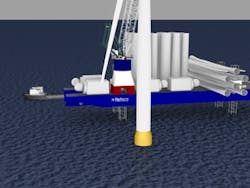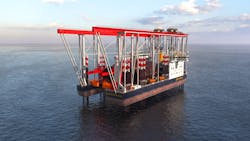Exec Q&A: Bleutec CEO addresses offshore wind turbine installation challenges
Founded in May 2018, Bleutec Industries has developed a fleet of vessels for offshore wind installation. The Houston-based startup’s mission is to build and operate installation vessels, which are all US Jones Act compliant, and provide a fit-for-purpose solution as a transportation and installation contractor for the offshore wind market.
In an Offshore exclusive, Bodtmann shared her insights on the current challenges and solutions facing the offshore wind sector regarding transportation, installation, operations and maintenance. She also detailed Bleutec’s new Binary Marine Installation Solution (BMIS) and how her team believes this vessel fleet concept will “revolutionize" the offshore industry.
Bleutec is working with marine engineers NETSCo and heavy-lift specialist Penthus to develop BMIS as an alternative to the more expensive heavy-lift jackup wind turbine installation vessels used in offshore wind market. The BMIS model is a three-unit spread built around two vessels (i.e., a piling installation vessel) with a hydraulic hammer, gantry crane and deck-space for batches of piles, along with a field service operation vessel for accommodation and crew support to work in up to 50-m water depths. Both vessels will run off dual-fuel and have lithium-ion battery backup onboard.
Offshore: What was the motivation behind forming Bleutec?
Bodtmann: Bleutec was founded as a clean energy company to address the supply chain needs as it relates to offshore winds construction services in the US Jones Act market. We are a collaboration of a people with experiences in the offshore industry, both traditional energy and renewables.
Offshore: What are your company's key targets looking ahead to 2023 and 2024?
Bodtmann: 2023 and 2024 will be heavily focused on vessels construction and operational readiness activities such as workforce development and rounding out of provisional elements of our scope. Our team will be heavily engaged with customer relationship development and understanding the potential tenure procurement of our vessels.
Offshore: What transportation and installation challenges are offshore wind developers facing, and how can these be addressed?
Bodtmann: First and foremost, there is a significant shortage foreseen in available assets to install windfarms offshore globally. This problem is even greater for the heavier and larger monopile foundations foreseen for the future, where many units do not have the necessary lifting capacity.
In addition, and particularly looking at the US, the Jones Act is preventing components to be moved by an international vessel. This requires a different approach to the logistics for supplying wind turbine components to the offshore site.
By providing Jones Act vessels with much less complexity, the building time and fabrication budgets are optimized to the best extent possible. This will enable the delivery of vessels within the project requirements and potential to scale up fast. With an additional international value, the vessels will be constructed to be able to install the largest and heaviest monopile foundations foreseen in the market. Furthermore, Jones Act-compliant vessels will be a lot more flexible to provide more and better options for providing economical logistical solutions.
Offshore: What are the operations and maintenance obstacles, and are there solutions yet?
Bodtmann: Particularly in the US market, there is a shortage of trained workforce that will need to be developed to support offshore wind activities. Globally, this would apply to most markets with the exception of the European market. Developers can and need to partner with local workforce development agencies to invest in the local economy to ensure buy in and support. Certainly, we can leverage existing offshore operations and maintenance capabilities in the traditional energy space. However, in a lot of instances, those traditional resources are not necessarily in the same regional areas.
Offshore: How is Bleutec’s BMIS concept different from or more efficient than similar vessels available on the offshore market?
Vessel classification is being developed through ABS and key OEM [original equipment manufacturing] providers, including Liebherr, Wartsila and Kongsberg.
BMIS is specifically designed to address cabotage markets in that our vessels are more cost effective, less complex and [provide] shorter fabrication times without compromising capability. In fact, there is only one other vessel in the world capable of the capacities of our piling installation vessel. What this allows is for BMIS to be replicated outside of the US Jones Act market globally where protectionist policies exist.
Our vessels are also multipurpose, which improves the business financial models and helps mitigate investment risks.
Offshore: Do you have any recent case study details you can share?
Bodtmann: Not at this time, but we will have one very soon as we are working with our customers to highlight this.
Offshore: In your opinion, what is the path forward for the offshore wind sector?
Bodtmann: This is somewhat clear yet complex. Overall, there is significant developments in fixed and floating wind and project execution. The capital costs will need to be optimized both from a means and methods and technological advances.
As the WTG sizes continue to increase, the challenge will be to manage the construction offshore in a cost-effective safe approach. Bleutec has already made advances in improving cost efficiencies and safety in fixed wind and is also heavily engaged in the innovation and solution development of floating wind.
07.26.2022
About the Author
Ariana Hurtado
Editor-in-Chief
With more than a decade of copy editing, project management and journalism experience, Ariana Hurtado is a seasoned managing editor born and raised in the energy capital of the world—Houston, Texas. She currently serves as editor-in-chief of Offshore, overseeing the editorial team, its content and the brand's growth from a digital perspective.
Utilizing her editorial expertise, she manages digital media for the Offshore team. She also helps create and oversee new special industry reports and revolutionizes existing supplements, while also contributing content to Offshore's magazine, newsletters and website as a copy editor and writer.
Prior to her current role, she served as Offshore's editor and director of special reports from April 2022 to December 2024. Before joining Offshore, she served as senior managing editor of publications with Hart Energy. Prior to her nearly nine years with Hart, she worked on the copy desk as a news editor at the Houston Chronicle.
She graduated magna cum laude with a bachelor's degree in journalism from the University of Houston.




